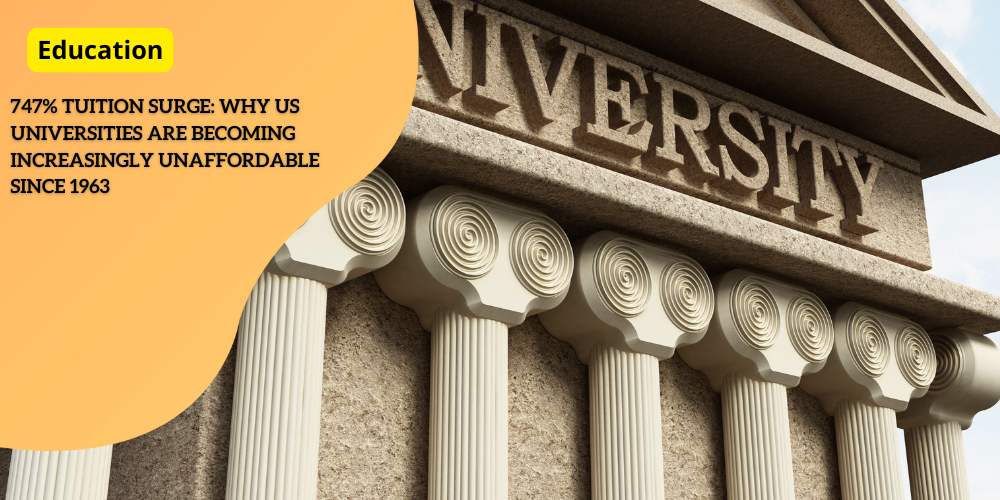747% Tuition Surge: Why US Universities Are Becoming Increasingly Unaffordable Since 1963

Anúncios
Inflation-Adjusted Tuition Surge
The landscape of higher education in the United States has drastically shifted since 1963.
When adjusted for inflation, college tuition has soared by a staggering 747.8%, reshaping how Americans perceive and afford education.
Anúncios
This substantial rise in costs has primarily impacted how both private and public institutions operate.
Comparison of Costs
Private Colleges: Private college tuition has seen considerable growth, increasing by 4% annually. This brings the average yearly tuition cost to nearly $40,000.
Anúncios
The significant burden on families is evident, especially when considering the total annual cost at institutions like Harvard can reach an eye-watering $95,438 when inclusive of living expenses.
Public Colleges: Public universities present comparatively lower costs but have not escaped the inflationary trend. The average annual tuition is around $10,500.
This still marks an increase, although less aggressive than their private counterparts, adding to the cumulative financial pressure on students and their families.
| Category | Details |
|---|---|
| 💰 Financial Planning | Families must plan and save diligently, often starting years ahead to manage educational expenses. |
| 💳 Debt Accumulation | Many students become heavily reliant on student loans, exacerbating the national student debt crisis. |
| 🚪 Opportunity Access | High costs create a barrier, limiting access to educational opportunities for lower and middle-income families. |
The increasing financial strains have stirred national conversations about the future of higher education funding and accessibility.
As universities continue to balance quality education with escalating costs, the key drivers behind these rising costs play a crucial role in understanding this economic burden.
Key Drivers Behind Rising Costs 📈
The staggering rise in college costs can be attributed to several key drivers which have steadily raised the financial strain on students and their families.
Three significant factors are high faculty salaries and benefits, massive investments in infrastructure, and reduced state funding. 📊
High Faculty Salaries and Benefits 💼
One of the primary drivers of rising tuition costs is the high salaries and benefits allocated to faculty members, especially at prestigious universities.
Renowned professors command substantial salaries due to their expertise, research contributions, and the prestige they bring to the institution. 🎓
In addition to competitive salaries, universities offer extensive benefits packages, including health insurance, retirement plans, and other perks. 🏥
These expenses create a significant financial burden that is ultimately passed on to students in the form of higher tuition fees. 💰
Massive Investments in Infrastructure 🏗️
Another major contributor to the escalating costs of higher education is the substantial investment in campus infrastructure. 🏢
Many universities are pouring millions of dollars into constructing modern buildings, state-of-the-art laboratories, and sophisticated student facilities.
For instance, adding cutting-edge technology and research laboratories can enhance the educational experience but also lead to substantial financial outlays. 💻
Such investments are intended to attract students and faculty by creating a more appealing and competitive environment, but they inevitably drive up operational costs, which are then reflected in tuition fees. 📈
Reduced State Funding 💸
A critical factor affecting the financial health of public universities is the reduction in state funding.
Over the years, many states have slashed their contributions to public higher education, forcing these institutions to rely more heavily on tuition revenue.
According to recent data, reduced state support has resulted in public universities raising tuition fees to cover the shortfall. 📊
This change imposes an extra financial strain on students, who then must resort to higher levels of student debt to afford their education.
These key drivers create a complex financial landscape for universities, leading to the continuous increase in tuition costs.
Addressing these issues is essential to alleviate the growing affordability crisis and guarantee that higher education stays available to a wider variety of students. 🎓
The Luxury Arms Race
Competing for Wealthy Students
Over the years, colleges and universities in the United States have increasingly engaged in what has been termed the “Luxury Arms Race.”
This phenomenon involves institutions competing to attract wealthy students by offering premium amenities and services.
Modern campuses now boast upscale dormitories, gourmet dining options, and state-of-the-art recreational facilities, all designed to lure in affluent families who can pay full tuition rates.
The Rise in Administrative Costs
Another key factor contributing to rising college costs is the surge in administrative expenses.
From 2010 to 2018, administrative costs at universities increased by 29%, significantly outpacing the 17% rise in faculty spending during that same period.
Much of this administrative growth relates to the management of these new amenities and services, as well as the expanding bureaucratic structures within universities.
Upscale Campus Facilities
Universities are no longer just places of learning; they have become mini-cities that offer everything from luxury apartment-style dorms to advanced fitness centers.
Though these facilities enhance the student experience, they come at a steep price.
The costs of building and maintaining such infrastructure are substantial, and these costs are often passed down to students in the form of higher tuition and fees.
Operational Costs Skyrocket
Operational costs extend beyond maintaining plush dorms and gourmet cafeterias.
Universities also invest heavily in other non-academic perks such as 24/7 tutoring services, mental health resources, and elaborate orientation programs.
While these services are beneficial, they also contribute to the ballooning operational budgets of educational institutions.
A Transition Point
The relentless climb in college costs due to the Luxury Arms Race is just one facet of a multifaceted problem.
As universities continue to broaden their appeal through lavish amenities, the financial burden on students intensifies, creating a complex landscape where access and affordability collide.
The Growing Affordability Crisis
Financial Burden on the Average American
The sheer financial commitment required to attend a top-tier university today is staggering.
The typical American family would need to save consistently for 75 years to afford the costs of a prestigious institution. This mind-boggling reality is a testament to how education expenses have skyrocketed over the years.
In 2022, the median savings amounted to just $5,011, barely a dent toward covering such exorbitant tuition fees.
The current situation creates a significant barrier for many families who value higher education but find themselves priced out of the market.
Ballooning Student Loan Debt
The burden doesn’t stop at tuition fees alone. Student loan debt in the United States has reached crisis levels, soaring to $1.6 trillion.
This leaves many graduates shackled with financial burdens that can take decades to repay.
For young professionals entering the workforce, this debt frequently postpones achievements such as purchasing a home, starting a family, or investing for retirement.
It’s a debt trap that threatens their long-term financial well-being, mirroring the larger affordability issue plaguing American higher education.

Inadequate Wage Growth 💼
Compounding these challenges is the sluggish pace of wage growth. Over the last 40 years, average wages have increased only by 19%, barely rising enough to offset living costs, let alone the soaring educational expenses. 📉
This imbalance highlights a widening gap between income and educational costs, making it increasingly difficult for families to justify the investment in a college degree when weighed against the slow rate of return.
The growing affordability crisis underscores the urgent need for reevaluation and reform within the higher education sector.
As pressures mount, an increasing number of students and families are exploring alternative education models and solutions. 🧐
Impact on Access and Equity ⚖️
The Wealth Gap and Educational Access
The growing costs of higher education in the United States are not just a financial issue but also pose significant challenges to educational access and equity.
As college tuition skyrockets, educational opportunities become concentrated among affluent families. 💵
These families can pay for expensive tuition fees, thus accessing prestigious institutions.
Meanwhile, less wealthy families struggle to afford even public university costs, leading to a concentration of educational opportunities at higher socioeconomic levels. 📊
Barriers to Diversity 🌍
The high costs associated with attending universities are a formidable barrier for students from lower-income backgrounds. 🚧
These financial hurdles limit diversity within campuses, often creating a more homogenous student body in terms of economic status and racial or ethnic background.
Despite scholarships and financial aid, the upfront costs and perceived debt burden can deter many talented students from even applying to top-tier institutions. 💳
This shift not only reduces diversity but also narrows the range of perspectives and experiences within academic settings. 🎓
Declining Confidence in Higher Education
The financial strain of pursuing higher education is taking its toll on public confidence.
A recent survey indicates that only 36% of Americans trust higher education as a worthwhile investment.
As tuition and associated costs rise more quickly than wages, skepticism grows regarding the value proposition of a college degree.
Concerns revolve around whether the long-term financial benefits of higher education can outweigh the immediate and prolonged financial costs.
This crisis of confidence dovetails with broader societal debates about the role of higher education and the effectiveness of current funding models.
Understanding these dynamics highlights the need for systemic changes to foster inclusivity and rebuild trust in higher education across all demographics.
As these challenges persist, an exploration of alternative educational paths and solutions becomes critical.
There is an increasing need for innovative, accessible models that can bridge the gap between affordability and quality education.
The Path Forward 🔮
As the discussion of soaring college costs unfolds, it’s critical to think about potential solutions.
The current model is unsustainable for many, and it’s essential to seek ways to ensure higher education remains accessible. 🎓
This chapter will dive into the growing interest in alternative education models, the necessity for increased state funding, financial aid reforms, and the ongoing debate over sustainable cost models for higher education.
Exploring Alternative Models: The Rise of Online Programs 💻
With sky-high tuition fees, many students are turning to alternative education models. One popular option is online programs.
These are generally more affordable than traditional in-person classes and offer flexibility that can accommodate different lifestyles and financial situations.
Online education can provide high-quality learning experiences without the hefty price tag associated with on-campus amenities and overhead costs. 💰
Expanding online programs can also democratize access to education.
Learners from various backgrounds and areas can access top-notch education without the need for relocation.
This accessibility could be a game-changer in bridging the gap between education affordability and quality. 🎓
The Crucial Role of Increased State Funding 💵
Enhanced state funding is a cornerstone in the quest to reduce college costs. 🏛️
Over the years, reduced state budget allocations have forced universities to rely more on tuition revenue, significantly impacting students’ financial burdens.
Reversing this trend can alleviate some pressures and make public universities more accessible to a wider range of demographics.
Empowered by state funds, universities could afford to lower tuition rates, invest in essential student services, and reduce dependency on exorbitant tuition hikes. 📉
This shift requires strong advocacy, informed policy discussions, and diligent state and federal budgeting priorities. 🗣️
Overhauling Financial Aid Systems 🏦
Financial aid reform is another critical factor in making higher education affordable. 🎓
A reimagined financial aid system could include expanding grants, scholarships, and implementing low-interest student loan programs.
Current financial aid options often fail to meet the total cost of attendance, leaving students with substantial loan debts.
A focused approach on increasing financial aid availability and ensuring it effectively reaches the neediest students is paramount.
This would also involve simplifying the application process to ensure more students can access aid. 📑
Debating Sustainable Cost Models
The broader discussion around higher education also invites debates on sustainable cost models.
Current models driven by high faculty wages, luxury campus services, and diminished state subsidies are proving unsustainable.
As a community, exploring models that balance both financial viability and educational quality is essential.
Different stakeholders, including educational institutions, governments, and private donors, need to come together to craft sustainable, long-term funding models.
These might include revisiting income-sharing agreements (ISAs), where students pay a percentage of their income after graduation instead of upfront tuition, or hybrid models that integrate various funding approaches.
The future of higher education demands innovative thinking and collaboration.
As this conversation evolves, the ultimate goal remains clear: to ensure that quality education is available and affordable to all, regardless of their circumstances.
Transition
While these discussions point toward potential solutions, the path forward requires concerted efforts and open-mindedness.
It is essential to consider how each of these aspects can be integrated into a cohesive framework for higher education reform.







